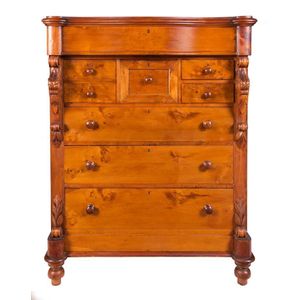Fluted Column Chest in Tasmanian Huon Pine (1885)
You must be a subscriber, and be logged in to view price and dealer details.
Subscribe Now to view actual auction price for this item
When you subscribe, you have the option of setting the currency in which to display prices to $Au, $US, $NZ or Stg.
- Column - An architectural feature sometimes used for decorative effect and sometimes as part of the supporting construction. Columns should generally taper slightly towards the top. They may be plain or decorated with carving, fluting or reeding. Columns may be fully rounded or, more commonly, half-rounded and attached with glue, screws or pins to the outer stiles of doors, or the facing uprights on cabinets and bureaux.
- Huon Pine - Named after the Frenchman who discovered the Huon River in Tasmania, it is an extremely slow growing and long living tree. Huon pine is native to Tasmania, and it can grow to an age of 3,000 years or more. The wood contains oil that retards the growth of fungi, hence its early popularity in ship-building in convict-era Tasmania. The timber is a warm yellow colour, finely grained, and was popular for household furniture in the Victorian era. Interestingly, much Huon pine furniture was made in South Australia. Huon pine is a protected species and only limited quantities are available nowadays, for craftsmen to manufacture small items such as platters, sculptures and other decorative objects.
- Circa - A Latin term meaning 'about', often used in the antique trade to give an approximate date for the piece, usually considered to be five years on either side of the circa year. Thus, circa 1900 means the piece was made about 1900, probably between 1895 and 1905. The expression is sometimes abbreviated to c.1900.
- Fluting - A form of decoration found on many pieces of furniture, as well as ceramics, silver and clocks, in which round-bottomed grooves, of varying width and depth, are let into columns, pilasters, legs. As a general rule, flutes are cut in the vertical, though they may follow a turned leg in a spiral pattern. In cross-section, they may be described as a series of 'U' shapes, rising and narrowing at each end of the groove. Fluting is the opposite of reeding, with which fluting is often associated.
This item has been included into following indexes:
- chests of drawers, material
- chests of drawers, style - eight drawer 85
Visually similar items

Late 19th century New Zealand Colonial kauri Scotch chest with two deep drawers, two short drawers, three long drawers below within bobbin turned column supports on turned feet

A huon pine eight drawer chest with serpentine front and carved corbels, Circa 1870. 151 cm high, 122 cm wide, 59 cm deep

A Colonial Australian cedar chest of drawers with shaped columns and carved corbels, Baltic pine secordary timbers, possibly South Australian origin, circa 1850s, 126 cm high, 127 cm wide, 60 cm deep

A George III mahogany chest on chest, the upper section with square fret pediment, blind fret cornice, five cock-bead edged drawers with attractive cast brass bale handles and Rococo escutcheons, flanked by fluted canted corners, the lower section with a b
